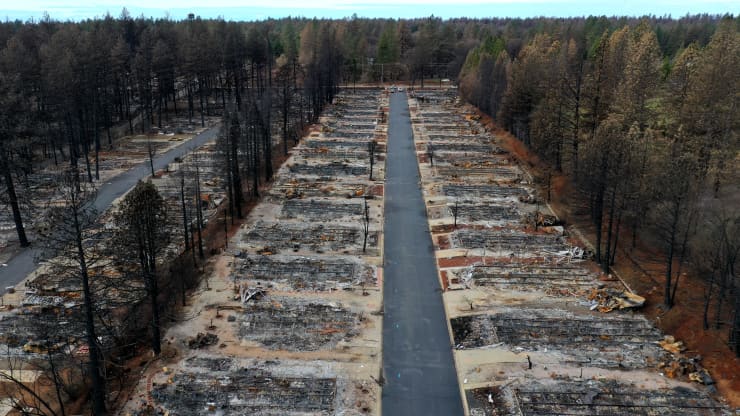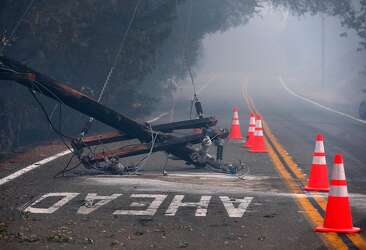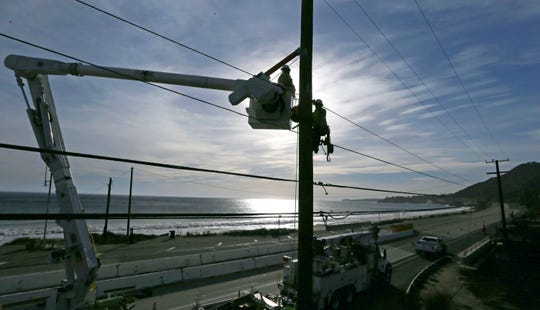They already had that discussion last year, and here's the rub:
1) The increase on the monthly bill would be 10x just to move overhead lines into the ground, because underground wires cost 10 times more than overhead.
2) Underground wires would be even more liable to damages since concrete-floored Californian cities floods like a mofo every time there's a storm, plus the ground below that concrete is constantly shifting back and forth from the weekly earthquakes.
3) Annual maintenance cost for underground wires inside the cities would be astronomical, when they have to dig up the roads and repave them for miles each time a simple inspection and troubleshooting is required.
Long story short, some stretches of wires in remote areas outside the city - especially in the areas where the fire risks are high - will be put in the ground, but the vast majority of the state's power grid where people actually live will remains overhead, for both economical and safety reason.
Here's more recent data on the astronomical costs of putting overhead wires underground inside Californian cities that I mentioned earlier.
Why not bury California's fire-prone power lines underground? The reason is sky high
Janet Wilson, Palm Springs | Desert Sun Oct. 11, 2019
Why can't California's fire-prone power lines be buried underground, out of harm's way?
That was the question many Californians were asking this week as hundreds of thousands of customers lost power in the Sacramento and San Francisco areas in preemptive shutoffs by Pacific Gas & Electric. Further south, another 200,000 customers of other utilities faced warnings that they too could lose power due to high winds.
Experts say the answer is simple: money.
"It's very, very expensive," said Severin Borenstein, a UC Berkeley professor of business administration and public policy who specializes in energy. Borenstein was speaking through the crackly static of a cell phone outside his darkened home in the San Francisco suburb of Orinda on Thursday evening. The Berkeley campus was shut down and his home had lost power too after PG&E instituted a mandatory "de-energization" across nearly 40 counties due to high fire threats.
It costs about $3 million per mile to convert underground electric distribution lines from overhead, while the cost to build a mile of new overhead line is less than a third of that, at approximately $800,000 per mile, according to a section on PG&E's website called
Facts About Undergrounding Power Lines.
California has 25,526 miles of higher voltage transmission lines, and 239,557 miles of distribution lines, two-thirds of which are overhead, according to CPUC. Less than 100 miles per year are transitioned underground, meaning it would take more than 1,000 years to underground all the lines at the current rate.
$15,000 for every PG&E customer?
PG&E, the state's largest utility, maintains approximately 81,000 miles of overhead distribution lines and approximately 26,000 miles of underground distribution lines. It also has about 18,000 miles of larger transmission lines, the majority of which are overhead lines.
At a cost of $3 million per mile, undergrounding 81,000 miles of distribution lines would cost $243 billion. PG&E has 16 million customers; distributing that expense equally would amount to a bill of more than $15,000 per account.
"It's very expensive," said Constance Gordon, a public information officer with the California Public Utilities Commission. "The utilities don't want to pay for it out of their pockets, so ratepayers would have to pitch in, and people don't want to pay for that."
PG&E is not flush with cash: The investor-owned utility filed for bankruptcy in January, facing $11 billion in liabilities related to wildfires. This week, the company's shares tumbled after a federal bankruptcy judge ruled that the utility no longer had the sole right to shape the terms of its reorganization.
Underground costs can vary depending on trenching and paving. If gas and telephone utilities share costs with electric companies, conversion costs can come down, but it all comes out of the customer's pocket eventually.
A report prepared by the Edison Electric Institute,
“Out of Sight, Out of Mind, An Updated Study on the Undergrounding of Overhead Power Lines,” found that while most new commercial and residential developments across the United States tuck electrical facilities underground,burying existing above-ground electric distribution systems can cost up to $5 million a mile in urban areas.
Environmental concerns would also be high if thousands of miles of trenches were dug through forests or brushland habitat, Borenstein noted. Opposition could also arise from residents in existing neighborhoods confronted with the prospect of heavy-duty earth-moving projects.
Neighborhoods can tax themselves to bury lines
Since 1967, the California Public Utilities Commission has had a rule requiring utilities to contribute funds to communities for utility conversion projects from overhead to underground infrastructure, paid for partially by ratepayers.
The CPUC has a longstanding policy that if a neighborhood wants underground power lines, it can have it done if residents pay for it themselves, with some required contributions from utilities. Sometimes developers and cities are willing to pitch in for certain areas, but the process is still labyrinthine.
That program does not prioritize lines in high wildfire hazard risk zones, but some residents in communities that experienced wildfires, including coastal Malibu and Rancho Palo Verde, have pushed for that policy to change to prioritize risky areas.
Sometimes the concerns are more centered on aesthetics than safety, and communities are willing to pay, or to have their local governments work to find funding. In the city of Palm Desert in the Coachella Valley, for example,
residents' demands to bury unsightly lines led the city council to approve a $600 million underground utility plan in October 2018. But that's just the beginning of the process.
If residents want the utility lines moved underground, they have to initiate creating a special district to tax themselves to pay for the project. To create a special district, residents need to collect signatures, and residents within the district's boundaries need to vote on the issue. In Palm Desert, the city hopes to help fund some of these projects, such as by paying for the portion of the move underground that is on public property.
Electric wires are increasingly placed underground in areas of new construction for aesthetic reasons, with developers picking up the cost. And in Paradise, where the devastating 2018 Camp Fire sparked by a power line flattened most of the town and killed 86 people, PG&E is preparing to lay underground lines.
"I don't know if I agree with it," said Borenstein of that plan, who thought it could offer a false sense of security. "Though when you are starting from scratch, it is much cheaper if all the houses have burned."
But Borenstein and others noted that problems can occur underground as well. Animals can chew buried lines or lightning can short out ground connections, just as animals can damage lines overhead, or a dry tree branch can drop. The state's extremely varied landscapes are another challenge.
"In some places undergrounding works, and in some places it doesn’t," said Mark Ghilarducci, director of the Governor's Office of Emergency Services. "California’s topography is challenging. ... I do know PG&E has taken a concerted effort, as well as all the utilities, to do undergrounding where possible."
Governor signs more than 20 fire-related bills
The solutions for PG&E's fire-prone wires are straightforward, but will take time
after years of neglect, said a clearly irritated Gov. Gavin Newsom at a Thursday press conference. PG&E needs to be brought into the 21st century in terms of technology, and the utility's equipment needs to be "hardened" against fire threats and maintained properly, he said.
"But to harden and upgrade 100,000 miles of line, come on, that's not gonna happen in a week or two, or even a month or two, or a year or two," said Newsom.
Earlier this month, Newsom signed into law over 20 wildfire-related bills, including SB 70, authored by Senator Jim Nielsen (R-Gerber). that measure requires the state's three big utilities to include in their wildfire mitigation plans consideration of undergrounding utility lines in the highest fire hazard risk areas. It does not force the utilities to take action.
SB 584, introduced by Sen. John Moorlach (R-Orange County), would require electrical corporations to invest funds for overhead to underground electrical infrastructure conversion projects by July 2020. The projects would be partially funded by grants from the Department of Forestry and Fire Protection. But the bill has languished on the floor.
Borenstein agreed that vegetation management and hardening transmission and distribution lines are better, more easily implemented alternatives than burying 100,000 miles of lines.
"That means mowing, cutting trees, perhaps replacing wooden poles with concrete poles, and all the rusted transmission towers," he said. "They're trying to do these things, but they have a huge backlog of work."
Other possible measures include insulating exposed lines or installing sensors, including cameras or devices that can detect a spark or a short and even shut down a line automatically.
https://www.desertsun.com/story/new...ia-fire-prone-power-lines-why-not/3937653002/




